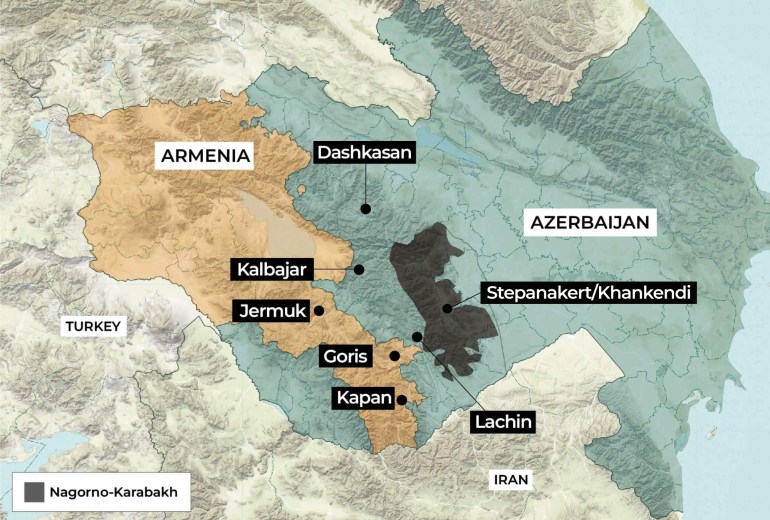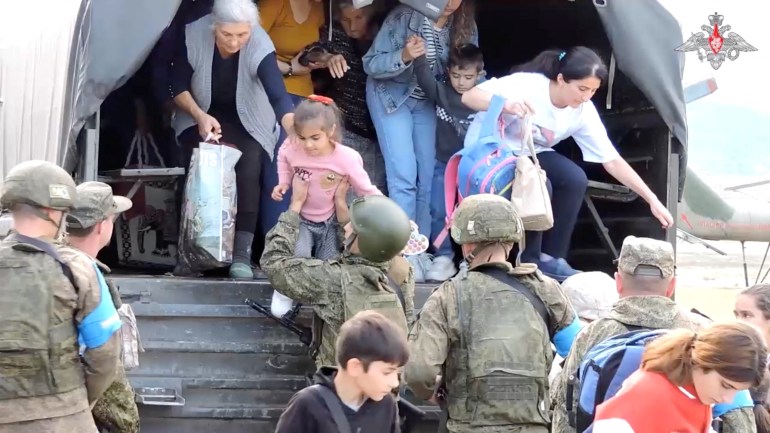Separatist Armenian forces in Nagorno-Karabakh have agreed to the terms of a ceasefire proposed by Russian peacekeepers, after suffering a series of battlefield setbacks at the hands of the Azerbaijani forces.
The surprise announcement on Wednesday looks to avert further escalation of the conflict, which reportedly claimed 32 lives and injured hundreds within 24 hours, although the prospect of a more long-lasting peace remains uncertain.
Azerbaijan began its “antiterrorist” operation in Nagorno-Karabakh on Tuesday after some of its troops were allegedly killed by armed separatists sympathetic to Armenia.
Karabakh is recognised internationally as part of Azerbaijan, although 120,000 ethnic Armenians live and dominate the region.
Armenian Prime Minister Nikol Pashinyan had earlier accused Azerbaijan of trying to provoke a war between the two neighbouring nations that are both allies of Russia.
Here’s what you need to know about the ceasefire and the long-running conflict between Azerbaijan and Armenia.

What’s in the latest ceasefire deal?
The separatist Armenian forces said that Azerbaijan had broken through their lines and seized a number of heights and strategic road junctions.
In such circumstances, the self-styled “Republic of Artsakh” said that it had no choice but to cease hostilities.
Azerbaijan’s Ministry of Defence also said that Armenian forces in Karabakh had agreed to “lay down their weapons, abandon combat positions and military posts and completely disarm”, adding that all weapons and heavy equipment were being handed over to the Azerbaijani army.
Baku had demanded that the separatist political authorities in Karabakh disband before any talks are held about the future of the region, which Azerbaijan wants to fully integrate.
Russia’s Ministry of Defence said that the ceasefire will be implemented in coordination with Russian peacekeepers. Armenia’s Pashinyan said Yerevan was not involved in preparing the text of the ceasefire.
“We hope that military escalation will not continue, because, in the current conditions, it is very important to ensure stability and stop combat actions,” Pashinyan said in a TV address to Armenians.
He also noted that Armenia has not had troops in Karabakh since August 2021.

What was the international reaction to the ceasefire?
In Moscow, Russian President Vladimir Putin said that his government is in contact with all sides of the conflict, adding that the Russian peacekeepers will do everything to protect civilians.
During a meeting with China’s Foreign Minister Wang Yi, Putin said that Russia expects to achieve a peaceful settlement of the situation in Nagorno-Karabakh.
“I hope that we can reach de-escalation and transfer a solution to this problem onto a peaceful course,” he added.
For his part, Armenian Deputy Foreign Minister Paruyr Hovhannisyan said that the ethnic Armenians of Azerbaijan’s Nagorno-Karabakh region could “in an ideal world” live under Azerbaijani rule, but that historical experience made it hard to imagine.
In an interview with the Reuters news agency, he said Armenia understood that Karabakh’s Armenians were open to talks with Baku, and that dialogue was crucial.
A first meeting to discuss the ceasefire agreement between authorities from Nagorno-Karabakh and Azerbaijan will take place on Thursday in the Azerbaijani city of Yevlakh, according to news reports.
Such a deal would put Azerbaijan close to achieving all its objectives, while any further fighting could increase the risk of a bigger war between Azerbaijan and Armenia.
Before the “antiterrorist” operation, clashes along their shared border were not infrequent, and tensions remain high despite the latest truce announcement.
Hikmet Hajiyev, foreign policy adviser to Azerbaijan’s president, told a news conference on Wednesday that the disarmament of Karabakh forces would improve the chances of successfully reintegrating the territory, as well as the prospects of peace with Armenia.
He dismissed calls for UN Security Council involvement, saying any issues needed to be solved on the ground.
What’s the origin of the Nagorno-Karabakh conflict?
The conflict between Azerbaijan and Armenia over Nagorno-Karabakh has been going on for decades.
Complicating the issue is the centuries-old tensions between Christian Armenians and Turkic Muslim Azeris.
Both countries fought a brief but brutal war over the area, in which more than 6,000 people were killed.
The ex-Soviet Caucasus rivals have been locked in a dispute with large-scale hostilities breaking out in the 1990s and in 2020.
The last large-scale conflict in Nagorno-Karabakh lasted for six weeks in 2020 before a Russian-brokered truce.
The ceasefire saw Armenia cede swathes of territory it had controlled since the 1990s, but an estimated 120,000 ethnic Armenians still call the area their homeland within the internationally recognised territory of Azerbaijan.
The ethnic Armenians living in the area get access to Armenia through the Lachin Corridor.

What is the Lachin Corridor’s part in the conflict?
The Lachin Corridor is the single highway connecting Armenia and the mountainous Nagorno-Karabakh that is home to an estimated 120,000 ethnic Armenians.
The road has been policed by Russian peacekeepers since 2020.
In mid-December of 2022, Armenia accused Azerbaijan of blocking the highway, thereby cutting Yerevan’s direct access to the ethnic Armenians.
Azerbaijani activists, however, claim that ethnic Armenians were involved in the illegal exploitation of the area’s natural resources, prompting the blockade.
According to reports and data, the Nagorno-Karabakh region is home to various natural resources, among which are minerals such as nonferrous metal ores and gold worth billions of dollars, making the area highly contentious.
Why is the volatile South Caucasus significant?
Developments over Nagorno-Karabakh could alter the geopolitical balance in the South Caucasus, where Azerbaijan is a major energy producer.
The region is crisscrossed with oil and gas pipelines, though none are in close proximity to Nagorno-Karabakh itself, and any conflict between Azerbaijan and Armenia could have major repercussions beyond the region.
Azerbaijan’s primary route for oil exports is the Baku-Tbilisi-Ceyhan (BTC) pipeline, which accounts for about 80 percent of country’s oil exports and runs via Georgia and onto the Turkish Mediterranean coast. It has a capacity of 1.2 million barrels per day or more than one percent of global oil supplies.
Azerbaijan also exports oil via Russia through the Baku-Novorossiysk pipeline and via Georgia by rail, as well as a pipeline from Baku to Supsa in Georgia.
Azerbaijan also exports gas to Europe. Gas production from its Azeri-Chirag-Guneshli (ACG) fields totalled 13.4 billion cubic metres (bcm) in 2022, while 25.2 bcm was produced from the Shah Deniz gas project, where BP is leading an international consortium.
Azerbaijan exported 6.6 bcm of natural gas to Europe in January-July.
Meanwhile, Armenia is home to the Metsamor Nuclear Power Plant, which is already in a precarious situation due to earthquake risk.
